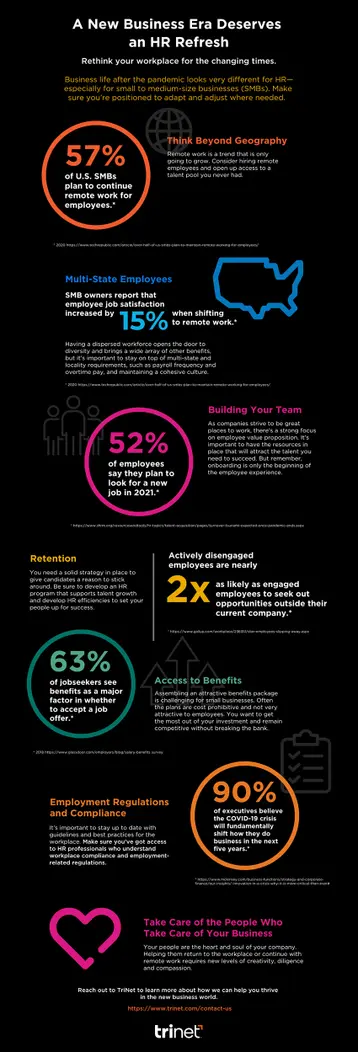
Table of contents
- 1.Think Beyond Geography
- 2.Multi-State Employees
- 3.Building Your Team
- 4.Nurturing Employee Retention
- 5.Access to Benefits
- 6.Employment Regulations and Compliance
- 7.Take Care of the People Who Take Care of Your Business
The Covid-19 pandemic has changed the way employers and employees look at day-to-day business and where that work is done. Naturally, business life after the pandemic looks very different for HR—especially for small to medium-size businesses (SMBs).
In many cases, the businesses that survived the pandemic were those that were able to pivot to address their market’s changing demands and adapt their service delivery model for efficiency and to meet the changing climate.
The same applies to the post-Covid business world. Those companies that are prepared to adapt and adjust where needed will be in a better position over their competitors. Here are human resource tips to navigating HR in a post-covid world.
Think Beyond Geography
There are advantages to having your team centrally located, able to collaborate together and bounce ideas of one another. But many of those advantages can be met with your team geographically disbursed. Remote work is a trend that is only going to grow, which is why businesses need a practical way to set up their teams for success—wherever they are based.
A recent study by Intermedia found that 57% of U.S. SMBs plan to continue remote work for their employees.1 What’s even more surprising? Of those businesses surveyed, nearly 85% of their employees worked in a centralized office pre-pandemic. This indicates that work from home is not just a passing phase. A remote workforce can open up access to a talent pool you never had and it may even be a valuable tool for recruiting employees.

Multi-State Employees
Having a workforce distributed among multiple states minimizes the need for relocation, opens the door to diversity and brings a wide array of other benefits, but you also need to stay on top of multi-state and locality requirements, such as payroll frequency and overtime pay, and maintaining and maintaining a cohesive culture.
“In the study by Intermedia, SMB owners reported that employee job satisfaction increased by 15% when shifting to remote work.1 Wherever your team works from, it’s important to have a reliable source of information and guidance for various employment-related compliance concerns in the states where your employees are based.
Building Your Team
Before you post your next job, think about why someone would want to join your company. Recruiting is sales and you need to offer something people want to buy. As companies strive to be great places to work, there is a strong focus on employer brand and employee value proposition. But the sales pitch doesn’t stop once you attract the talent you need. Employees expect certain advantages as part of their employment relationship. A survey of 2,000 employed adults in February 2021 found that 52% are looking for a new job, up from 35% a year earlier.2
It's important to have a solid strategy in place to give candidates a reason to join your team. And it’s also important to remember that onboarding is only the beginning of the employee experience.
Nurturing Employee Retention
As your workforce grows, so does your investment in people. Your success depends on getting the right talent for your organization in the door and keeping them. Budgeting for HR is critical. You can’t cut corners on recruiting and benefits and expect to keep the best talent. You need a solid strategy in place to give people a reason to stick around. Be sure to develop an HR program that supports talent growth and develop HR efficiencies to set your people up for success.
The average cost per hire for U.S. employees can begin at around $500 per hire for lower skilled talent, up to as high as $4,400 per hire for technical and skilled labor in certain industries.3 Add to that onboarding and training and you can see that growth is expensive.
Access to Benefits
Assembling an attractive benefits package was challenging for small businesses before the pandemic. Are you prepared to provide health insurance for a geographically dispersed workforce? A Glassdoor study of jobseekers found that 63% of them see benefits as a major factor in whether to accept a job offer.4
Remember that health insurers and networks often vary by geography, so it’s important to have the right carriers, plans and networks wherever your employees are located. You want to get the most out of your investment and remain competitive without breaking the bank.
Employment Regulations and Compliance
A recent study of executives found that 90% of them believe the Covid-19 crisis will fundamentally shift how they do business in the next five years.5 Protecting your workers and your business requires understanding the facts as they emerge. Make sure you have a process for keeping up on guidelines and best practices for evolving workplace rules. Make sure you’ve got access to HR professionals who understand workplace compliance and employment-related regulations.
Take Care of the People Who Take Care of Your Business
Your people are the heart and soul of your company. Helping them thrive in a post-Covid workplace will require deep human resources expertise, as well as new levels of creativity, diligence and compassion.
We know this because although Covid-19 was a once-in-a-century health threat, navigating crises is nothing new to us. We’ve learned over the years that our team and the people we serve must always come first. That’s a core TriNet value and why we implemented changes to our operations, including transitioning TriNet colleagues to work from home and continuing to monitor federal, state and local guidance on dealing with the pandemic.
Doing so has helped us keep our people safe, healthy and as productive as possible. It has also enabled TriNet to continue to help our clients by providing full-service HR solutions. So in that spirit, we offer these human resource tips; in the hope and belief that, together, we will thrive in a post-pandemic business world.
- 2020 https://www.techrepublic.com/article/over-half-of-us-smbs-plan-to-maintain-remote-working-for-employees/
- 2021 https://www.shrm.org/resourcesandtools/hr-topics/talent-acquisition/pages/turnover-tsunami-expected-once-pandemic-ends.aspx
- 2017 https://www.shrm.org/ResourcesAndTools/business-solutions/Documents/Organizational%20Staff%20Size.pdf
- 2018 https://www.glassdoor.com/employers/blog/salary-benefits survey
- 2020 https://www.mckinsey.com/business-functions/strategy-and-corporate-finance/our-insights/ innovation-in-a-crisis-why-it-is-more-critical-than-ever#

TriNet Team
Table of contents
- 1.Think Beyond Geography
- 2.Multi-State Employees
- 3.Building Your Team
- 4.Nurturing Employee Retention
- 5.Access to Benefits
- 6.Employment Regulations and Compliance
- 7.Take Care of the People Who Take Care of Your Business




